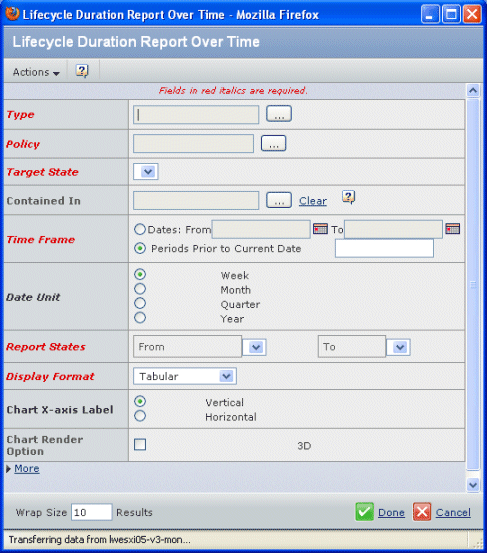Lifecycle Duration Report Over Time | |||||||
|
| ||||||
Fields

| Field Name | Description |
|---|---|
| Type | The object Type used to generate the report; click |
| Policy | If the type is associated with a single policy, the Policy field will be populated when you select the type and you cannot change it. Click |
| Target State | Select a state from the drop-down list. The list shows all states defined in the selected policy. The report will include only those objects that have reached the target state between the specified start and end dates. |
| Contained In | Click
|
| Time Frame | Select the Dates or Periods Prior to
Current Date option. If you choose Dates, use the If you choose Periods Prior to Current Date, enter a number in the box. |
| Date Unit | Choose: Week, Month, Quarter, or Year. For example, if you want to view lifecycle data for the past five months, choose Month. |
| Report States | Choose the states that you want
to include in the report. The report calculates the average time the
object spent in each selected state for each defined time period. All
states between the From state and the Two state will be included in the
report. Select the first state to include in the report from the From list. The default value is the first state defined for the policy. Select the last state to include in the report from the To list. The default value is the last state defined for the policy. The To State must be later than the From State. |
| Display Format | Choose Tabular, Bar Chart, Stack Bar Chart, or Line Chart. |
| Chart X-axis Label | If you selected a graphical format, choose whether the X-axis should display as Horizontal or Vertical. |
| Chart Render Option | If you selected a graphical format, select the 3D check box if you want to display the results of graphical reports in three dimensions. |
| Wrap Size # Results | (at the bottom of the screen). If you selected a Tabular format, specify the number of columns that should be displayed on one line in the report before wrapping. This setting prevents the report form becoming too wide for viewing. |
| More | Enter advanced critiera based on additional attributes of the selected
type, click More. See Entering Advanced Report Criteria. If you click More again to hide these attributes, any criteria you entered will not be used to generate the report. The More section must be open before clicking Done for those criteria to be used. |
If there is a problem with any of the parameters, such as a To date that is earlier than the From date, a message will display indicating which parameters need to be fixed before the report can be executed.
![]()
Actions Menu and Page Toolbar
| Action | Description | For details, see: |
|---|---|---|
| Open | Loads the criteria from a previously-saved report of this type. | Open Reports Page |
| View Results | Opens the results page for a previously-saved report of this type (does not use any criteria entered on this page). | View Results Page |
| Delete | Deletes a saved report. | Deleting a Report |
| Save | Saves the criteria entered on this page as a new report. | Saving Report Criteria |
| Save As | Saves the criteria entered on this pages over an existing report, or as a new report. | Saving the Report Criteria as a Different Report |
